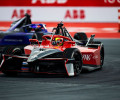From Auto #17: Question: how will fans be watching motor sport in 10 years?
AUTO asks three experts for their opinion on how spectators will consume motor sport in a decade. Will virtual reality technology make a big impact in a sport where a driver’s-eye view of the racing might hugely enhance the viewing experience?

Click here to read the full Auto #17 magazine.
JESÚS HORMIGO - CTO, VIRTUALLY LIVE
In 10 years from now you’ll not distinguish real-time computer- generated graphics from footage, the same way you can distinguish computer graphics in movies nowadays.
Every sport will be tracked to a level of detail that was never tracked before. Your favourite player will wear trackers that will accurately measure not only their movements but breath rate, sweat levels, ECG and even the basic EEG bands giving you concentration levels and ERP readings for certain patterns in real time.
You will not be watching sporting events any more but you’ll be attending them, virtually, with your friends and you will feel as if you are there.
AR and VR will converge and the devices will be ultralight, having a battery that will last for days.
Sports will be reconstructed using computer graphics to give you the highest levels of detail and this will enable you to immerse in a virtual world where action is accurately recreated in real time.
New sports will arise out of this information excess and will be designed for the user to measure performance across the spectrum of mixed reality.
This will also be the source of a new fan base that will actually appreciate a different new set of skills from the traditional sports. eSports and traditional sports will converge in a virtual reality world, where any real or fantasy sport will take place anytime with global audiences.
Computer ‘clusters’ will play sports only using artificial intelligence based on the patterns it has learned from the behaviour of real ones. New stars being born out of AI and not existing in the real world will play against the AI model of the existing ones.
ZAK BROWN - EXECUTIVE DIRECTOR, MCLAREN TECHNOLOGY
“I think Virtual Reality will be applied to many motor sport viewpoints, from cars to drivers’ helmets, to pit stops, to trackside views you can’t physically stand in because of safety. The 360-degree cameras already in use today, such as at 360racing.com, will only get even better in quality and smaller, allowing you to put them in places that have previously been inaccessible.
How cool would it be to watch the Belgian Grand Prix trackside at Eau Rouge? Or when a car pits from the lead of a grand prix, to watch the pit stop from the tyre-changer’s helmet? Or if it’s the Le Mans 24 Hours, from the perspective of the refueller? But unlike TV, where you’re being directed, you choose what you see – you are the director.
As these cameras get smaller and smarter, you’ll be able to do even more cool stuff – like showing how the car is working. You could see what goes on in the driver’s footwell, or inside the wheelwell, so you could see the suspension and tyre working, and the brakes lighting up. We’ve seen glimpses on traditional TV, but to see it live, while deciding what to look at next adds an extra dimension.
Today’s consumer, certainly the millennials, want to engage and even interact – to be as ‘in-the-game’ as possible. Virtual Reality offers that immersive and interactive experience. Generally, if you look at the growth in video gaming and the 3D experience it offers, and the way consumers are migrating to VR technology, there’s no doubt that younger audiences wish to consume their entertainment in this format. A lot of that is sports – the majority driven via social media.
In addition, I think there’s a clear safety aspect to Virtual Reality, as well as enforcing track limits and even technical regulations. Of course, that’s not for consumers but it goes to show the multiple layers in which VR can work.
ALEJANDRO AGAG - CEO, FORMULA E
It’s a really interesting question and something we ask ourselves regularly when looking at the future of Formula E. Formula E isn’t just pioneering in terms of performance on the track, but also in the way we interact with our fans.
The way we consume not just motor sport, but sport in general, is changing all the time. I don’t think many people have the luxury of dedicating hours each day to watching sport at home, no matter how much you love it. People are on the move – I know it’s a phrase I use regularly, but I truly believe that the future of urban mobility is electric, driverless and connected. This also ties in with the way we go about our daily lives, consuming sports coverage on the move. Fans follow their favourite sport from their fingertips on their phone. I still believe in watching sports live at the event and also from the comfort of your own home – but fans expect more, a second screen experience when watching the race from trackside, or live streaming while doing your weekly shop. Formula E is looking at new ways to do just that.
One area that Formula E has been actively pursuing is gaming and eSports – we even have our first virtual race in Las Vegas at CES in January, where 10 fans will be competing against the Formula E drivers for the chance to win a share of $1 million. This shows that fans may not only be watching motor sport in 10 years, but actually participating in it! It’s vital we offer fans an immersive experience to bring them closer to the sport than ever before. Formula E does this through FanBoost, where fans can vote for their favourite driver to receive an extra power boost during the race – fans can feel that they have a direct influence on the result. We saw this in Mexico last season, where Lucas di Grassi used FanBoost to overtake Jerome D’Ambrosio for the lead of the race.
The other element linked to how fans are now gaming or viewing motor sport is through virtual reality. Fans want to be able to follow their favourite driver with a selection of onboard views and 360-cameras – virtual reality allows you to do this. We have been trialling this with Virtually Live, which allows you to follow the action on a virtual reality headset – sit in the car, or even stand up and move around the car as they are racing on track. I tried it in Long Beach last season and I was blown away. Looking up and seeing the skyscrapers, and checking behind to see where your closest rival is – it takes motor sport viewing to a whole new level.

 Facebook
Facebook Twitter
Twitter






